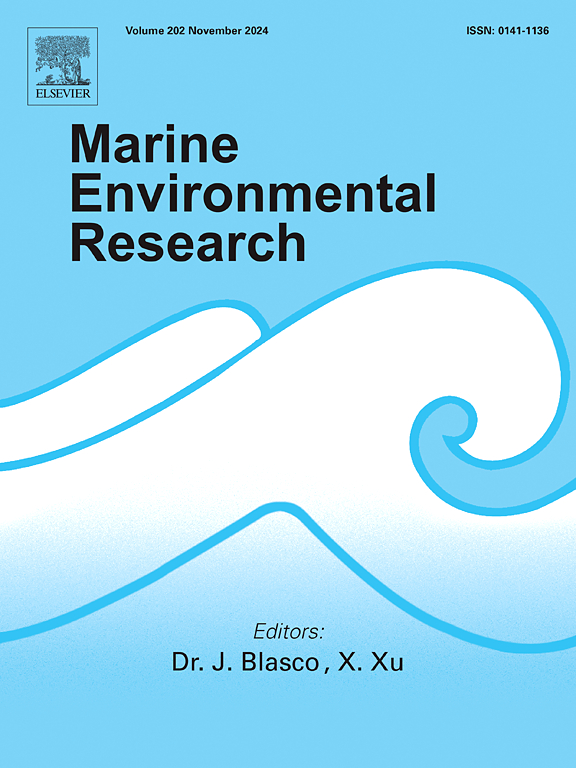Earlier onset of phytoplankton bloom in the Southern Bight of the North Sea in response to climate variability
IF 3.2
3区 环境科学与生态学
Q2 ENVIRONMENTAL SCIENCES
引用次数: 0
Abstract
Phytoplankton are essential to marine ecosystems, driving biogeochemical cycles and supporting diverse marine species and systems. Shifts in bloom timing of these species can disrupt food webs and carbon cycling. This study investigates changes in the timing and composition of phytoplankton blooms in the Belgian Part of the North Sea (BPNS) and examines the environmental drivers behind these shifts. We analyzed data from 2018, 2019, and 2021, combining remote sensing, in situ measurements, flow imaging microscopy, and DNA metabarcoding to assess phytoplankton community structure and bloom phenology. Typically, two major annual blooms occur in this region: a mid-spring bloom dominated by Phaeocystis globosa and an early-summer diatom bloom primarily consisting of Thalassiosira species. In 2021, both blooms occurred approximately one month earlier than in 2018 and 2019. Contrary to expectations, this advance in blooming was not associated with higher sea temperatures or increased light availability (quantified by photosynthetically active radiation). Instead, we observed increases in phosphate concentrations and reductions in salinity preceding the blooms. These changes suggest that alterations in nutrient dynamics and salinity acted as bottom-up controls, triggering the earlier onset of phytoplankton blooms and supporting the Disturbance Recovery Hypothesis.
由于气候变化,北海南湾的浮游植物开花时间提前
浮游植物对海洋生态系统至关重要,推动生物地球化学循环,支持多种海洋物种和系统。这些物种开花时间的变化会破坏食物网和碳循环。本研究调查了北海比利时部分(BPNS)浮游植物繁殖时间和组成的变化,并研究了这些变化背后的环境驱动因素。我们分析了2018年、2019年和2021年的数据,结合遥感、原位测量、流动成像显微镜和DNA元条形码来评估浮游植物群落结构和水华物候。通常情况下,该地区每年会出现两次主要的水华:以球形Phaeocystis globbosa为主的仲春水华和主要由Thalassiosira物种组成的初夏硅藻水华。2021年,这两次水华都比2018年和2019年提前了大约一个月。与预期相反,这种开花的进展与较高的海水温度或增加的光可用性(通过光合有效辐射量化)无关。相反,我们观察到,在水华之前,磷酸盐浓度增加,盐度降低。这些变化表明,营养动态和盐度的变化起着自下而上的控制作用,触发了浮游植物繁殖的早期发生,支持了干扰恢复假说。
本文章由计算机程序翻译,如有差异,请以英文原文为准。
求助全文
约1分钟内获得全文
求助全文
来源期刊

Marine environmental research
环境科学-毒理学
CiteScore
5.90
自引率
3.00%
发文量
217
审稿时长
46 days
期刊介绍:
Marine Environmental Research publishes original research papers on chemical, physical, and biological interactions in the oceans and coastal waters. The journal serves as a forum for new information on biology, chemistry, and toxicology and syntheses that advance understanding of marine environmental processes.
Submission of multidisciplinary studies is encouraged. Studies that utilize experimental approaches to clarify the roles of anthropogenic and natural causes of changes in marine ecosystems are especially welcome, as are those studies that represent new developments of a theoretical or conceptual aspect of marine science. All papers published in this journal are reviewed by qualified peers prior to acceptance and publication. Examples of topics considered to be appropriate for the journal include, but are not limited to, the following:
– The extent, persistence, and consequences of change and the recovery from such change in natural marine systems
– The biochemical, physiological, and ecological consequences of contaminants to marine organisms and ecosystems
– The biogeochemistry of naturally occurring and anthropogenic substances
– Models that describe and predict the above processes
– Monitoring studies, to the extent that their results provide new information on functional processes
– Methodological papers describing improved quantitative techniques for the marine sciences.
 求助内容:
求助内容: 应助结果提醒方式:
应助结果提醒方式:


